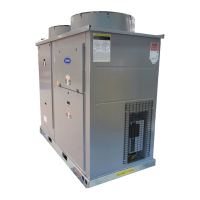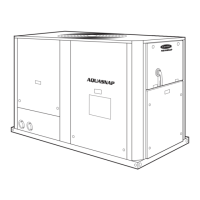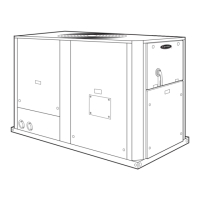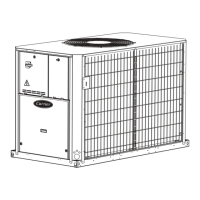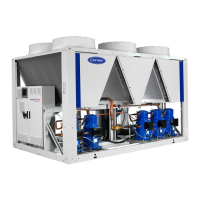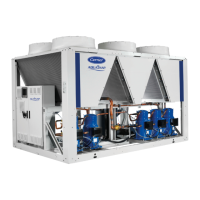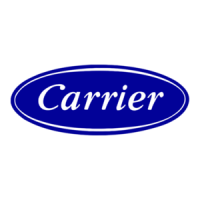75
1. If pump impeller diameter is known:
a. Connect a differential pressure gage across the pump at
the ports provided on the pump volutes.
b. Read GPM from applicable impeller curve.
2. If pump impeller diameter is not known:
If pump impeller diameter has been trimmed and the size is
not known, it is necessary to determine which impeller curve
to read.
The easiest way to confirm pump performance is to “dead-
head” the pump and read the differential pressure across the
pressure ports on the pump. “Dead-heading” can be done by
shutting the circuit setter valve on the discharge side of the
pump.
NOTE: Although not all pumps can be safely “dead-headed,”
centrifugal pumps (such as on the 30RAP units) can be
“dead-headed” for short amounts of time. It is recommended
to keep the time short due to excessive heat build-up in the
pump.
Since the “dead-head” condition is a no-flow condition, the
head will correspond to the intersection of an impeller curve
with the vertical axis of the pump chart. The correct impeller
diameter is that which corresponds to the measured head.
3. Once the impeller diameter is known, proceed as in Step 1.
4. Water flow rate can be determined by using a differential
pressure gage with the Bell & Gossett circuit setter balance
valve calculator or Armstrong Circuit Balancing Valve Slide
Rule. (This information is also provided in the installation
instructions.) This method will not directly measure pressure
differential seen by the pump, but can be used to “double-
check” the pump measurement.
5. Verify that cable connections at the switch and at the terminal
block are secure.
6. For factory-installed hydronic system, verify that:
a. All air has been purged from the system.
b. Circuit setter balance valve has been correctly set.
7. Pump impeller has been improperly trimmed and is not pro-
viding sufficient flow.
8. Wrong pump motor rotation. Pump must rotate clockwise
when viewed from motor end of pump.
PUMP MODIFICATIONS AND IMPELLER TRIMMING
See applicable section in the Installation instructions.
RESET OF CHILLER WATER FLOW
See applicable section in the Installation instructions.
CHANGING OF PUMP SEALS
See service instruction manual provided with the hydronic
package.
VFD OPERATION
For units with factory-installed VFD (variable frequency drive)
option, see service instruction manual provided with the hydronic
package. Default password is 00002323.
MAINTENANCE
Recommended Maintenance Schedule
The following are only recommended guidelines. Jobsite condi-
tions may dictate that maintenance schedule is performed more of-
ten than recommended.
ROUTINE:
• Periodic clean water rinse, especially in coastal and indus-
trial applications.
• Check condenser coils for debris, clean as necessary.
EVERY MONTH:
• Check moisture indicating sight glass for possible refriger-
ant loss and presence of moisture.
EVERY 3 MONTHS (FOR ALL MACHINES):
• Check refrigerant charge.
• Check all refrigerant joints and valves for refrigerant leaks,
repair as necessary.
• Check chilled water flow switch operation.
• Check all condenser fans for proper operation.
• Check compressor oil level.
• Check crankcase heater operation if equipped.
EVERY 6 MONTHS:
• Check chilled water flow switch sensor tip for buildup.
Clean if necessary. See page page 67.
EVERY 12 MONTHS (FOR ALL MACHINES):
• Check all electrical connections, tighten as necessary.
• Inspect all contactors and relays, replace as necessary.
• Check accuracy of thermistors, replace if greater than
± 2°F (1.2°C) variance from calibrated thermometer.
• Check to be sure that the proper concentration of anti-
freeze is present in the chilled water loop, if applicable.
• Verify that the chilled water loop is properly treated.
• Check refrigerant filter driers for excessive pressure drop,
replace as necessary.
• Check chilled water strainers, clean as necessary.
• Check cooler heater operation, if equipped.
• Check condition of condenser fan blades and that they are
securely fastened to the motor shaft.
• Perform Service Test to confirm operation of all
components.
• Check for excessive cooler approach (Leaving Chilled Wa-
ter Temperature — Saturated Suction Temperature) which
may indicate fouling. Clean cooler vessel if necessary.
Condenser Coil Maintenance and Cleaning
Recommendations
Routine cleaning of coil surfaces is essential to maintain proper
operation of the unit. See the following sections:
• MCHX condenser coils — See page 61.
• RTPF condenser coils — See page 61.
Control Box Maintenance
The control panel for 30RAP100-150 208/230 v and 380 v units
has two 24-v fans installed at the right side of the panel to modu-
late the inside temperature of the control box. These two fans are
controlled by a temperature switch. The temperature switch closes
at 120°F and opens at 105°F. The inlet filter is located at the left
side of the control box. Inspect the inlet filter and fan outlet screen
every three months, clean as needed.
TROUBLESHOOTING
Complete Unit Stoppage and Restart
Possible causes for unit stoppage and reset methods are shown be-
low and in Table 43. Refer to Fig. 3-19 for component arrange-
ment and control wiring diagrams.
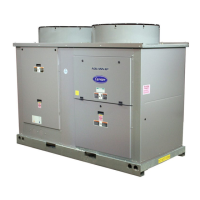
